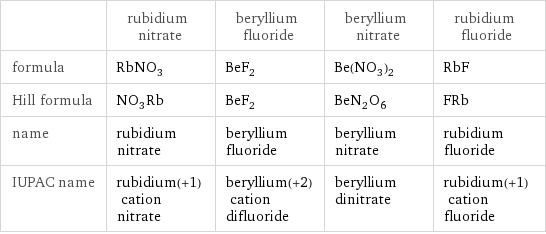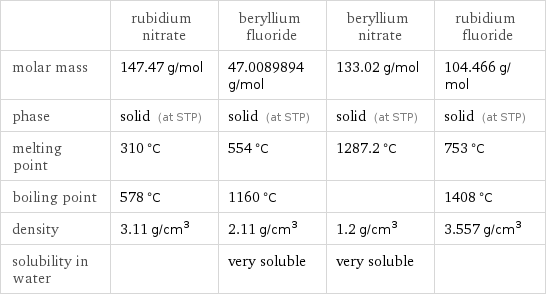Input interpretation

RbNO_3 rubidium nitrate + BeF_2 beryllium fluoride ⟶ Be(NO_3)_2 beryllium nitrate + RbF rubidium fluoride
Balanced equation

Balance the chemical equation algebraically: RbNO_3 + BeF_2 ⟶ Be(NO_3)_2 + RbF Add stoichiometric coefficients, c_i, to the reactants and products: c_1 RbNO_3 + c_2 BeF_2 ⟶ c_3 Be(NO_3)_2 + c_4 RbF Set the number of atoms in the reactants equal to the number of atoms in the products for N, O, Rb, Be and F: N: | c_1 = 2 c_3 O: | 3 c_1 = 6 c_3 Rb: | c_1 = c_4 Be: | c_2 = c_3 F: | 2 c_2 = c_4 Since the coefficients are relative quantities and underdetermined, choose a coefficient to set arbitrarily. To keep the coefficients small, the arbitrary value is ordinarily one. For instance, set c_2 = 1 and solve the system of equations for the remaining coefficients: c_1 = 2 c_2 = 1 c_3 = 1 c_4 = 2 Substitute the coefficients into the chemical reaction to obtain the balanced equation: Answer: | | 2 RbNO_3 + BeF_2 ⟶ Be(NO_3)_2 + 2 RbF
Structures

+ ⟶ +
Names

rubidium nitrate + beryllium fluoride ⟶ beryllium nitrate + rubidium fluoride
Equilibrium constant
![Construct the equilibrium constant, K, expression for: RbNO_3 + BeF_2 ⟶ Be(NO_3)_2 + RbF Plan: • Balance the chemical equation. • Determine the stoichiometric numbers. • Assemble the activity expression for each chemical species. • Use the activity expressions to build the equilibrium constant expression. Write the balanced chemical equation: 2 RbNO_3 + BeF_2 ⟶ Be(NO_3)_2 + 2 RbF Assign stoichiometric numbers, ν_i, using the stoichiometric coefficients, c_i, from the balanced chemical equation in the following manner: ν_i = -c_i for reactants and ν_i = c_i for products: chemical species | c_i | ν_i RbNO_3 | 2 | -2 BeF_2 | 1 | -1 Be(NO_3)_2 | 1 | 1 RbF | 2 | 2 Assemble the activity expressions accounting for the state of matter and ν_i: chemical species | c_i | ν_i | activity expression RbNO_3 | 2 | -2 | ([RbNO3])^(-2) BeF_2 | 1 | -1 | ([BeF2])^(-1) Be(NO_3)_2 | 1 | 1 | [Be(NO3)2] RbF | 2 | 2 | ([RbF])^2 The equilibrium constant symbol in the concentration basis is: K_c Mulitply the activity expressions to arrive at the K_c expression: Answer: | | K_c = ([RbNO3])^(-2) ([BeF2])^(-1) [Be(NO3)2] ([RbF])^2 = ([Be(NO3)2] ([RbF])^2)/(([RbNO3])^2 [BeF2])](../image_source/812fc4002259112d8143ec4f7ab5f0b2.png)
Construct the equilibrium constant, K, expression for: RbNO_3 + BeF_2 ⟶ Be(NO_3)_2 + RbF Plan: • Balance the chemical equation. • Determine the stoichiometric numbers. • Assemble the activity expression for each chemical species. • Use the activity expressions to build the equilibrium constant expression. Write the balanced chemical equation: 2 RbNO_3 + BeF_2 ⟶ Be(NO_3)_2 + 2 RbF Assign stoichiometric numbers, ν_i, using the stoichiometric coefficients, c_i, from the balanced chemical equation in the following manner: ν_i = -c_i for reactants and ν_i = c_i for products: chemical species | c_i | ν_i RbNO_3 | 2 | -2 BeF_2 | 1 | -1 Be(NO_3)_2 | 1 | 1 RbF | 2 | 2 Assemble the activity expressions accounting for the state of matter and ν_i: chemical species | c_i | ν_i | activity expression RbNO_3 | 2 | -2 | ([RbNO3])^(-2) BeF_2 | 1 | -1 | ([BeF2])^(-1) Be(NO_3)_2 | 1 | 1 | [Be(NO3)2] RbF | 2 | 2 | ([RbF])^2 The equilibrium constant symbol in the concentration basis is: K_c Mulitply the activity expressions to arrive at the K_c expression: Answer: | | K_c = ([RbNO3])^(-2) ([BeF2])^(-1) [Be(NO3)2] ([RbF])^2 = ([Be(NO3)2] ([RbF])^2)/(([RbNO3])^2 [BeF2])
Rate of reaction
![Construct the rate of reaction expression for: RbNO_3 + BeF_2 ⟶ Be(NO_3)_2 + RbF Plan: • Balance the chemical equation. • Determine the stoichiometric numbers. • Assemble the rate term for each chemical species. • Write the rate of reaction expression. Write the balanced chemical equation: 2 RbNO_3 + BeF_2 ⟶ Be(NO_3)_2 + 2 RbF Assign stoichiometric numbers, ν_i, using the stoichiometric coefficients, c_i, from the balanced chemical equation in the following manner: ν_i = -c_i for reactants and ν_i = c_i for products: chemical species | c_i | ν_i RbNO_3 | 2 | -2 BeF_2 | 1 | -1 Be(NO_3)_2 | 1 | 1 RbF | 2 | 2 The rate term for each chemical species, B_i, is 1/ν_i(Δ[B_i])/(Δt) where [B_i] is the amount concentration and t is time: chemical species | c_i | ν_i | rate term RbNO_3 | 2 | -2 | -1/2 (Δ[RbNO3])/(Δt) BeF_2 | 1 | -1 | -(Δ[BeF2])/(Δt) Be(NO_3)_2 | 1 | 1 | (Δ[Be(NO3)2])/(Δt) RbF | 2 | 2 | 1/2 (Δ[RbF])/(Δt) (for infinitesimal rate of change, replace Δ with d) Set the rate terms equal to each other to arrive at the rate expression: Answer: | | rate = -1/2 (Δ[RbNO3])/(Δt) = -(Δ[BeF2])/(Δt) = (Δ[Be(NO3)2])/(Δt) = 1/2 (Δ[RbF])/(Δt) (assuming constant volume and no accumulation of intermediates or side products)](../image_source/551dd1439ee20dd5f7db4b76a777275d.png)
Construct the rate of reaction expression for: RbNO_3 + BeF_2 ⟶ Be(NO_3)_2 + RbF Plan: • Balance the chemical equation. • Determine the stoichiometric numbers. • Assemble the rate term for each chemical species. • Write the rate of reaction expression. Write the balanced chemical equation: 2 RbNO_3 + BeF_2 ⟶ Be(NO_3)_2 + 2 RbF Assign stoichiometric numbers, ν_i, using the stoichiometric coefficients, c_i, from the balanced chemical equation in the following manner: ν_i = -c_i for reactants and ν_i = c_i for products: chemical species | c_i | ν_i RbNO_3 | 2 | -2 BeF_2 | 1 | -1 Be(NO_3)_2 | 1 | 1 RbF | 2 | 2 The rate term for each chemical species, B_i, is 1/ν_i(Δ[B_i])/(Δt) where [B_i] is the amount concentration and t is time: chemical species | c_i | ν_i | rate term RbNO_3 | 2 | -2 | -1/2 (Δ[RbNO3])/(Δt) BeF_2 | 1 | -1 | -(Δ[BeF2])/(Δt) Be(NO_3)_2 | 1 | 1 | (Δ[Be(NO3)2])/(Δt) RbF | 2 | 2 | 1/2 (Δ[RbF])/(Δt) (for infinitesimal rate of change, replace Δ with d) Set the rate terms equal to each other to arrive at the rate expression: Answer: | | rate = -1/2 (Δ[RbNO3])/(Δt) = -(Δ[BeF2])/(Δt) = (Δ[Be(NO3)2])/(Δt) = 1/2 (Δ[RbF])/(Δt) (assuming constant volume and no accumulation of intermediates or side products)
Chemical names and formulas

| rubidium nitrate | beryllium fluoride | beryllium nitrate | rubidium fluoride formula | RbNO_3 | BeF_2 | Be(NO_3)_2 | RbF Hill formula | NO_3Rb | BeF_2 | BeN_2O_6 | FRb name | rubidium nitrate | beryllium fluoride | beryllium nitrate | rubidium fluoride IUPAC name | rubidium(+1) cation nitrate | beryllium(+2) cation difluoride | beryllium dinitrate | rubidium(+1) cation fluoride
Substance properties

| rubidium nitrate | beryllium fluoride | beryllium nitrate | rubidium fluoride molar mass | 147.47 g/mol | 47.0089894 g/mol | 133.02 g/mol | 104.466 g/mol phase | solid (at STP) | solid (at STP) | solid (at STP) | solid (at STP) melting point | 310 °C | 554 °C | 1287.2 °C | 753 °C boiling point | 578 °C | 1160 °C | | 1408 °C density | 3.11 g/cm^3 | 2.11 g/cm^3 | 1.2 g/cm^3 | 3.557 g/cm^3 solubility in water | | very soluble | very soluble |
Units
